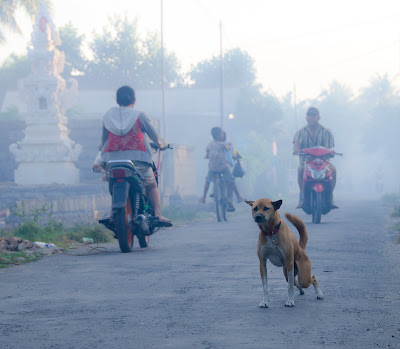Pura Goa Gajah. As before, Pura Goa means temple cave while Gajah means elephant in Indonesian. Below are three of the the seven springs which feed a pool. They represent the seven sources of the Ganges in India. The water that flows from them into the bathing pool is considered holy and is used to purify oneself.

The Balinese people are incredibly tolerant and inclusive. For the most part this extends to their holy places which often do not close and are open to visit day or night though you generally pay during the day. I haven't purchased the traditional clothing of the Balinese so I can't say for sure, but I would be surprised if you had to pay if you followed the traditions of the temple. Keep in mind that offerings are given and so money, cleaned with a flower, is a good substitute for the traditional offering regardless of denomination. So with this openness, we have been welcomed into ceremonies, anointed with flowers and rice, doused with holy water and generally made to feel welcome though stupid, all the while bearing the most genuine smile you're likely to face.
The entrance to the elephant cave itself. You can see the wear on the stone steps.
There are two parts to this temple, the first being the Hindu, partly shown above, the second is the Buddhist part shown below. These are the stairs down to the Buddhist area of the temple grounds. There was a statue which collapsed during one of the earthquakes, rebuilt and collapsed again. The remains are still there lying in a pool of water beneath a spring.

We had two guides. The bank machines give out fifty and hundred thousand rupiah notes (roughly 6-12 dollars Canadian), most tell you which you're getting with a sticker on the machine itself. Yet, sometimes, you just need money and you can't choose the smaller denomination. This sort of concern is irrelevant in most countries but when you buy locally here you're better to pay with smaller bills as the larger ones will incur exasperated looks and sometimes it can end the deal there and then. We had two ten thousand notes and a few of the hundreds. So when we entered the temple grounds and the first guide approached asking if we wanted his services we decided that twenty was as high as we would go as spending a hundred or asking for change was beyond our budget and out of the question. He accepted the twenty and took us around, it was good but efficient though fair for the price. Afterwards he said we could look around and go anywhere, really anywhere, it's that open here. So while Jacqueline was taking pictures I descended a steep slope down to the river and called for her to follow. There was a rope to hold as you went down but the upper part was missing and as she attempted to navigate it (none of this was dangerous, just perilous) a cleaner called out to her to get her to stop and showed her another way down. This photo is the first time he appeared even though we didn't notice him at the time... the rest of this will make more sense later.
So here he is, humble and happily waiting for us. The first I saw of him he was walking on the other side of the out-flow stream from the temple. Mouth red with betel nut juice, calling for me to cross the stream which was littered with garbage. I started to with the flimsy protection of my flip-flops as the only protection until he crossed to help me and instructed me to remove my shoes, that it would be fine, and to follow him. I did, and looking at the garbage around me, trekking through mud, I told myself that it is cleaner in many ways than the filth you can't see at home. He showed us the main river found in the "Glamour shots" post and then continued to show us around, laughing all the time most likely at us. From one spot in the temple to the next he took us and each one seemed like it was his most favorite place. Where the first guide showed us the ruins of the statue he took us behind them so we could see what remains of the carvings. He was a pleasure to be around and I don't know his name, but whatever he was I would bet he was closer to the divine than many of the priests. In the end we gave him a hundred thousand. We couldn't give him nothing and he deserved more than the first guide. This talk of money may strike you as petty but we're on the road for 8 months and throwing money around is foolish and ignorant. Its a part of traveling so it'll be a part of my blog.

The carvings of the broken statue. There were other larger ones as well but harder to discern what you're looking at other than man-made artifacts covered in moss.
Posed as Buddha under his tree.
The final shot as leaving of the moon above a holy tree.




















































